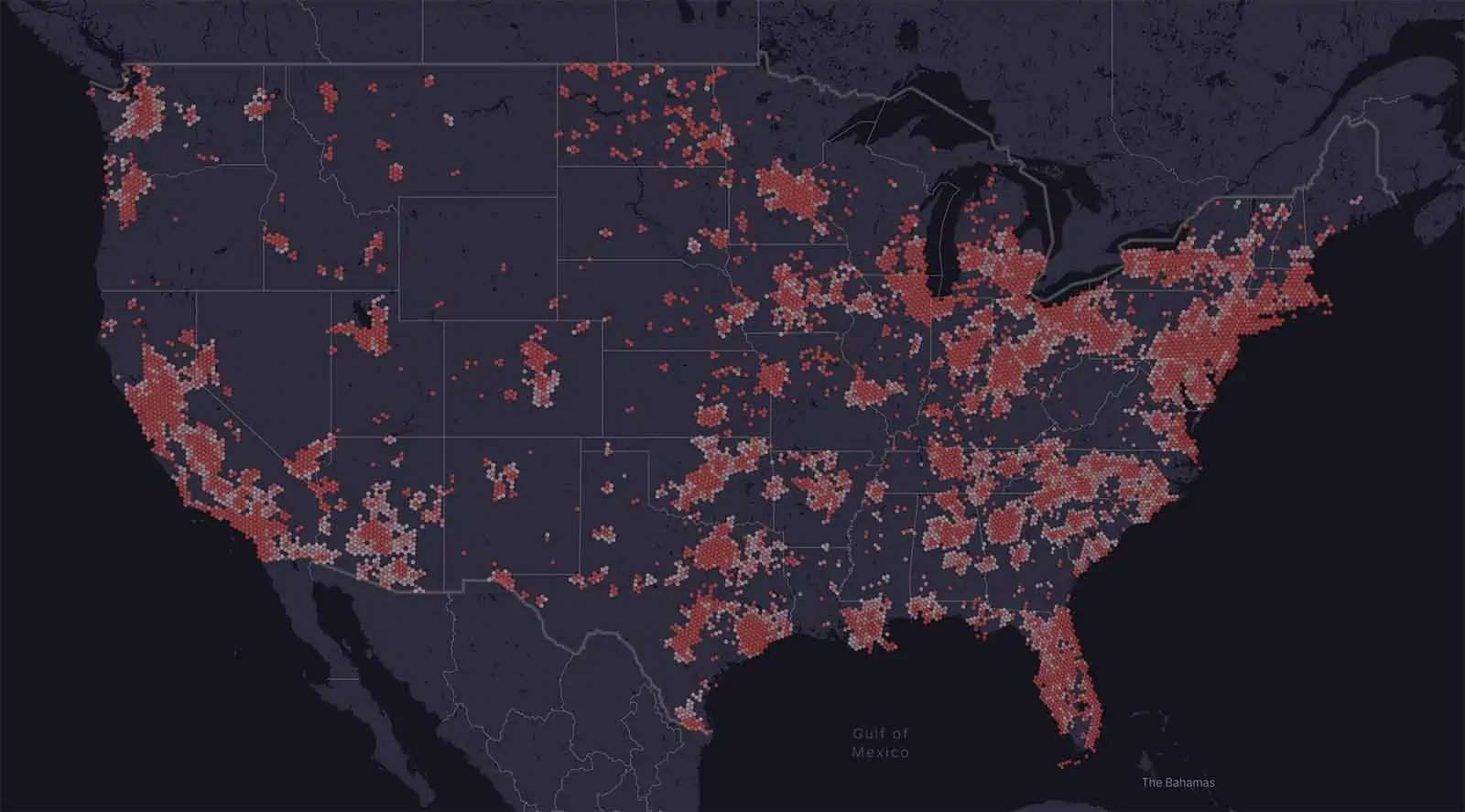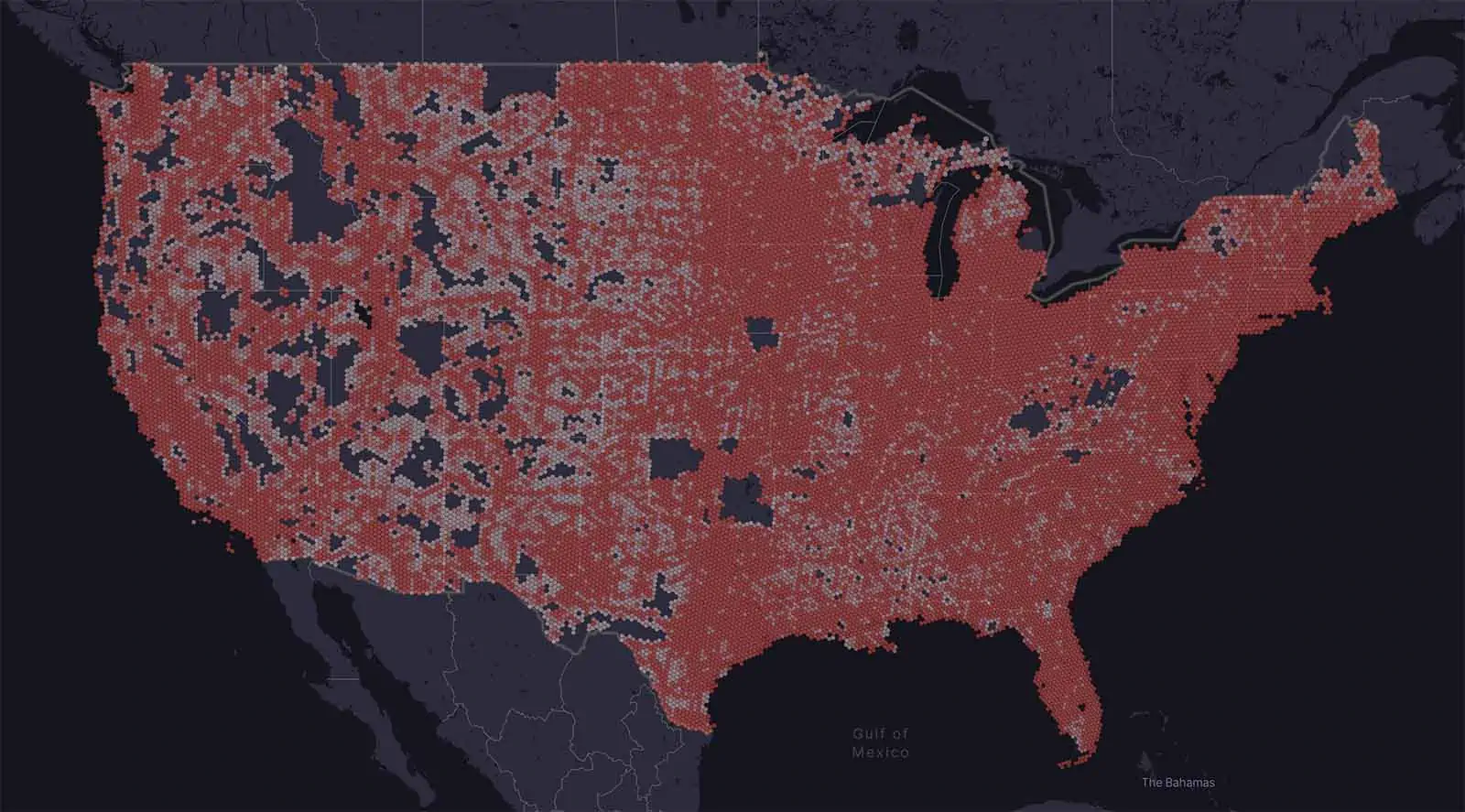Verizon Coverage
Fast facts about Verizon coverage in the continental U.S.:
- #2 most coverage overall
- Total area covered: 71.5%
- Total square miles covered: 5,775,641
- 5G area covered: 14.7%
- 5G square miles covered: 1,191,703
According to cellular signal strength data from the FCC, Verizon currently has the second largest overall network in the United States.
Its network covers 71.5% of the total land area in the continental U.S., which is about 5.78 million square miles.
Verizon's 5G network, meanwhile, is the third largest. It covers just 14.7% of the continental U.S. and provides about 1.19 million square miles of 5G coverage.
Despite having a small footprint, Verizon says its fast 5G Ultra Wideband network reaches over 222 million Americans.
Over 99% of Americans will get coverage on Verizon's LTE network.
That said, cellular coverage varies a LOT by location. You may be wondering, "how good is Verizon's coverage where I live?"
To find out how good Verizon's coverage is in your area, use our interactive map at the top of this page.
You can also download our free Coverage Map app for iPhone and Android.
Get the Free Coverage Map App
Measure your cellular data speeds. Compare cellular coverage. Completely free.

What network does Verizon use?
Verizon uses their own nationwide 4G LTE and 5G networks to provide coverage.
Verizon 5G Coverage
According to FCC data, Verizon is behind when it comes to 5G.
Verizon 5G only covers 14.7% of the U.S., which is less than T-Mobile (49.0%) and AT&T (41.4%).
Still, you don’t need to cover a lot of land area to cover a lot of people.
Verizon says its fast 5G Ultra Wideband network covers 222 million people, or around 60% of the U.S. population. And Verizon’s more extensive Nationwide 5G network covers over 230 million people, or just over 69% of the U.S. population.
Verizon is continuing to build out its 5G network, so you can expect its coverage footprint to continue expanding.
If you haven’t tried Verizon’s network in a while, it may be worth taking advantage of Verizon’s 30 day free trial.
Verizon LTE Coverage
Verizon’s LTE network is nationwide and covers over 98% of the US population.
Verizon Coverage by State
Verizon's network covers an impressive 71.5% of the United States.
But how good is Verizon's coverage in each individual state?
Here is a detailed breakdown on how good Verizon's coverage is in each state. You will see the total percentage of each state the Verizon network covers, as well as a breakdown of great, good, and poor coverage:
Verizon 5G Coverage by State
Verizon Data Speeds by State
An important part of how good a cellular network is is how fast the network is.
How fast is Verizon's network?
We compiled our crowd-sourced speed test data to find out. In the case of Verizon, its median download speeds ranged from 11.1 Mbps in Alaska and up to 135.3 Mbps in Washington, DC. Median upload speeds on Verizon ranged from 6.6 Mbps in Mississippi to 24.6 Mbps in Rhode Island. And median ping performance on Verizon ranged from 26 ms to 128 ms.
Verizon vs. AT&T Coverage
Verizon’s coverage is similar to AT&T’s coverage.
According to FCC data, Verizon covers 71.5% of the land area in the U.S. while AT&T covers 74.6%.
You may get a bit less coverage on Verizon in a few locations, but in general the two networks are very similar:
5G coverage is a different story though. Verizon has much worse 5G coverage than AT&T does. Verizon only covers 14.7% of the U.S. with 5G.
AT&T?
It blankets an impressive 41.4% of the country in 5G.
Data speeds on Verizon and AT&T are about the same.
According to data from our crowd sourced speed test map, Verizon's median download speeds are 61.23 Mbps and its median upload speeds are 11.65 Mbps.
AT&T's median download speeds are 61.17 Mbps and its median upload speeds are 11.29 Mbps, which is extremely similar to the performance on Verizon.
Both carriers will likely provide excellent coverage in and out of cities.
To figure out the best carrier in your area, you may want to try the check coverage tool and enter your ZIP code.
You can also check the AT&T coverage map to see what cell reception and data speeds on AT&T look like in your area.
Verizon vs. T-Mobile Coverage
Verizon coverage is better than T-Mobile coverage.
Verizon covers more of the United States than T-Mobile, with 71.5% total coverage compared to T-Mobile’s 59.5% total coverage.
However, Verizon has under one third as much 5G coverage as T-Mobile does. Just 14.7% of area is covered by Verizon 5G, compared to 49.0% covered by T-Mobile 5G.
Verizon is also slower than T-Mobile.
According to our crowd-sourced speed test map, Verizon's median performance is 61.23 Mbps for download and 11.65 Mbps for upload.
T-Mobile gets over 2.4x faster download speeds. Its median download speeds are 152.34 Mbps. T-Mobile's median upload speeds are 17.34 Mbps.
Both Verizon and T-Mobile will likely perform well in cities, with T-Mobile delivering faster speeds.
When it comes to getting service in rural areas though, Verizon’s greater coverage footprint may make it a better option.
Check our T-Mobile coverage map to see what reception and data speeds on T-Mobile look like in your specific area.
Verizon Coverage Frequently Asked Questions
Is Verizon coverage good?
Verizon has the largest coverage area of any cellular network and covers over 99% of Americans. For most people, Verizon will have good coverage.
Does Verizon offer 5G?
Yes. Verizon offers Nationwide 5G and Ultra Wideband 5G. Nationwide 5G covers more people, and Ultra Wideband 5G delivers super fast data speeds.
Does Verizon have coverage in Canada?
Yes. All of Verizon's postpaid plans include unlimited talk, text, and 2GB of high-speed data per day in Canada.
Does Verizon have coverage in Mexico?
Yes. All of Verizon's postpaid plans include unlimited talk, text, and 2GB of high-speed data in Mexico.
Does Verizon have international coverage?
Verizon charges $10 per day for international service for most of their plans. The international add-on is called the TravelPass, and it includes unlimited talk, text, and 2GB of high-speed data per 24-hour period in the country you're visiting.





